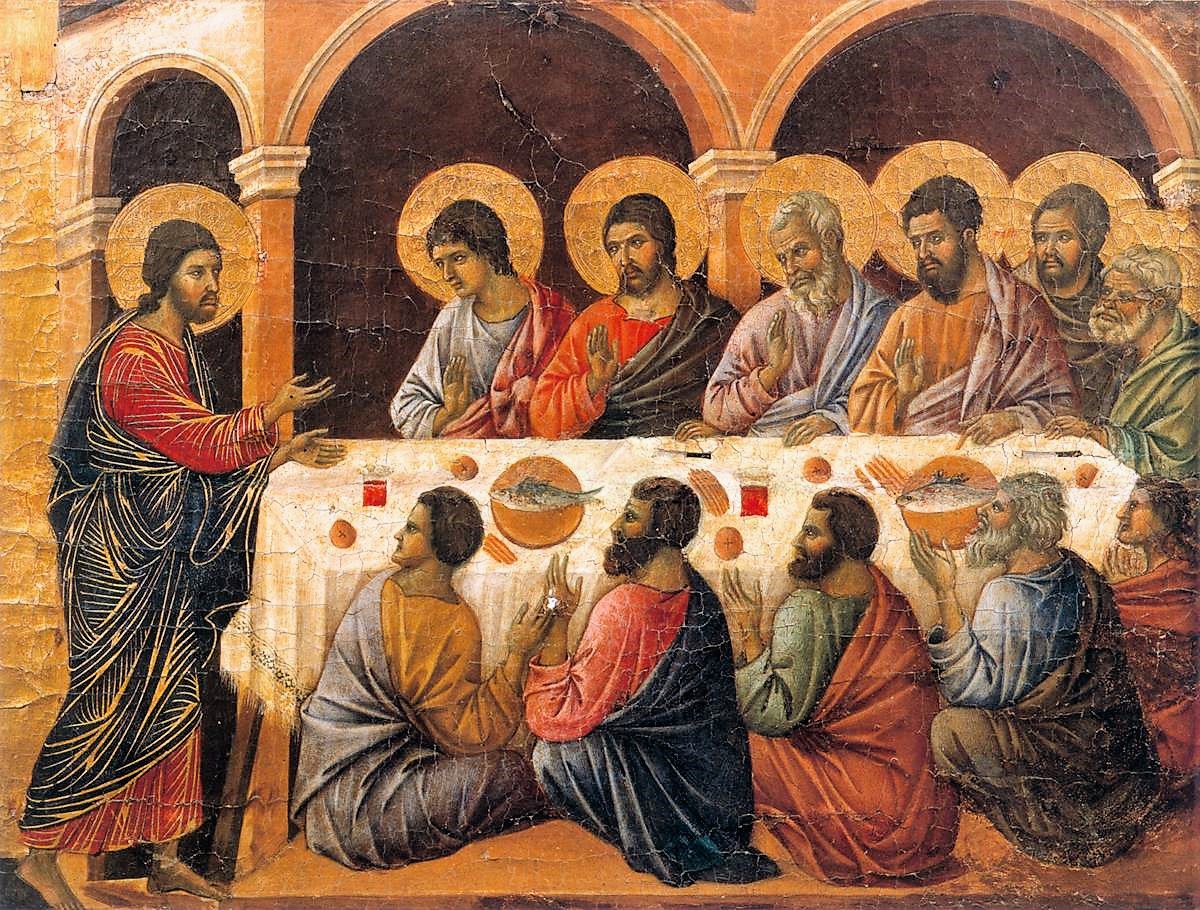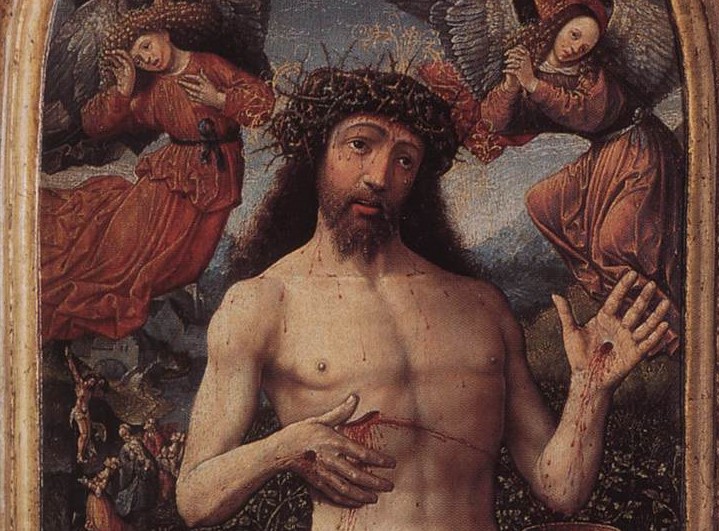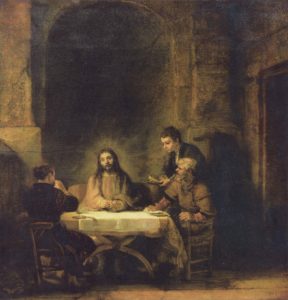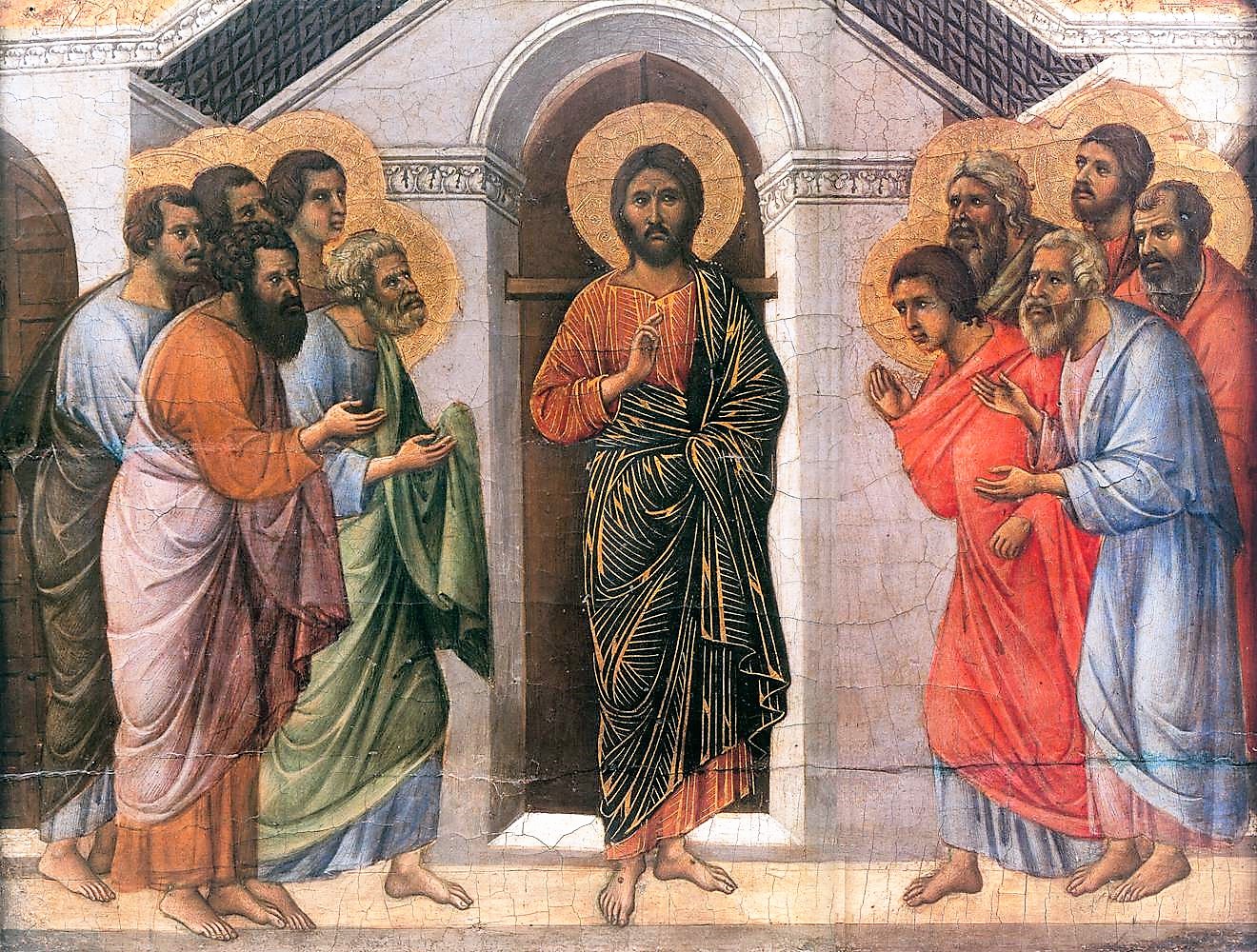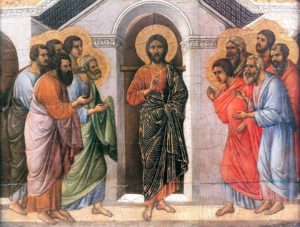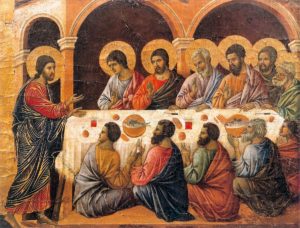
This Sunday’s Gospel speaks to the necessity of becoming witnesses of Jesus’ resurrection Jesus. It begins with the necessary foundation of the Church’s proclamation: The Lord has risen indeed, and he has appeared to Simon! (Luke 24:34) This solemn declaration forms the doctrinal certitude of the resurrection. On this foundation of the truth, the personal witness of every Catholic must be built. In this gospel we see how the Lord confirms His resurrection through the teaching authority of the Church, confirms the apostles in its truth, clarifies their faith, and then commissions them to be witnesses. Let’s see how the Lord does this.
I. The Certainty of the Resurrection – And [the disciples from Emmaus] rose that same hour and returned to Jerusalem. And they found the eleven and those who were with them gathered together, saying, “The Lord has risen indeed, and he has appeared to Simon!” Then they told what had happened on the road, and how he was known to them in the breaking of the bread.
In the early hours of the first Easter Sunday, the news began to circulate that Jesus was alive and had been seen. These reports were at first disbelieved or at least doubted by the apostles. They dismissed reports from both women and men. Several women, including Mary Magdalene, had seen Jesus alive. St. John had seen the empty tomb and had “believed.” And though Luke does not mention it here, Mark records that when the disciples returning from Emmaus first sent word they had seen Jesus, they too were at first disbelieved (Mk 16:13).
As we pick up the story that evening, there is a sudden change, a declaration by the apostles that the Lord has truly risen!
What causes this change? After the early evening report from the disciples returning from Emmaus, Peter slipped away, perhaps for a walk. According to both Paul (1 Cor 15:5) and Luke (Lk 24:34), the risen Lord then appeared to Peter privately, prior to making Himself known to any of the other apostles. Peter reports Jesus’ appearance to the others and it is at this point that the resurrection moves from being doubted to being the official declaration of the community, the Church. The official declaration is worded as follows: The Lord has truly risen, and he has appeared to Simon!” (Luke 24:34)
Did the women’s and the laymen’s declarations mean nothing? Of course not. Indeed, the Lord later upbraids the apostles for being so reluctant to accept the testimony of the others (Mk 16:14). He calls them “hard of heart” for this reluctance, especially given that He had said He would rise on the third day. Even to this day the Lord often presents apparitions of Mary, the saints, or Himself to the faithful. The clergy must carefully discern such actions, not quickly believing or disbelieving them. However, no apparition or devotion (e.g., the Divine Mercy Chaplet) can become official teaching of the Universal Church until the Church, in union with Peter’s successor, rules it worthy of belief.
This is even more the case with a dogma like the resurrection. It becomes an official teaching when proclaimed so by Peter and his successors. Pope Benedict, writing as Joseph Ratzinger, sees an ecclesiological dimension to Peter’s special role in causing the resurrection to go from being merely attested to being “true indeed.”
… This indication of names [Cephas and then the Twelve], … reveals the very foundation of the Church’s faith. On the one hand “the Twelve” remain the actual foundation stone of the Church, the permanent point of reference. On the other hand, the special task given to Peter is underlined here. … Peter’s special witnessing role is confirmation of his commission to be the rock on which the Church is built. … So, the resurrection account flows naturally into ecclesiology. … and it shapes the nascent Church [Jesus of Nazareth Vol 2., pp. 259-260].
So, the resurrection is now officially declared by the Church; it is certain and true. Faith is a way of knowing. Our faith in the Church as stated in the Creed (I believe in one, holy, catholic, and apostolic Church) leads us to the certain knowledge of the resurrection by the Church’s dogmatic declaration: The Lord has truly risen, and he has appeared to Simon!” (Luke 24:34)
However, even though the faith is a communal and official declaration of the Church through the College of Apostles with Peter as its head, it cannot remain simply this. Faith must reach every member on a personal level. It is not enough for us to say, “Peter says …,” or “The Church says …,” or “Scripture says …,” or “My mother says …” We must also be able to add our own voice to the witness of the Church. We must be able to say, “Jesus is risen; it is true! What the Church has always taught, I, too, have experienced. All her teachings and doctrines, all that the Lord has taught and revealed is true because in the laboratory of my own life I have tested them and found them to be true!”
Thus, we must stay with these disciples in their journey to experience the proclamation of the Church: “The Lord has truly risen, and he has appeared to Simon!”
II. The Contact with the Resurrection – While they were still speaking about this, he stood in their midst and said to them, “Peace be with you.” But they were startled and terrified and thought that they were seeing a ghost.
The truth, if we will lay hold of it, is consoling and freeing. Jesus, in the truth of His resurrected glory, stands before them and says, “Shalom,” peace. While the truth does liberate and bring peace, a journey is usually necessary to realize and accept this. Before we can receive the gift of truth, we must often accept the conflict that it introduces into our life.
As we all know, the truth can startle and even upset; it can break conventions and challenge what we know and think. The apostles are at first startled. It is one thing to hear and accept that the Lord is risen, that He has appeared to Peter, but it is another thing to be personally confronted with the truth.
It is one thing for them to believe with the Church and say, “The Lord is truly risen, and he has appeared to Simon!” But it is another for them to personally experience this. It breaks through everything they have ever known. Their belief is no longer abstract; it is no longer merely communal. Now they are personally in contact with the reality of it.
So, too, for us on our journey to deeper faith. It is a faith declared by the Church, but a faith that we must come to know and experience personally. Thanks be to God that the Lord is willing to help us to do so. For He does not simply shatter our notions. Rather, He helps us to “connect the dots” between His truth and what we already know.
III. The Clarification of the Resurrection – Then he said to them, “Why are you troubled? And why do questions arise in your hearts? Look at my hands and my feet, that it is I myself. Touch me and see, because a ghost does not have flesh and bones as you can see I have.” And as he said this, he showed them his hands and his feet. While they were still incredulous for joy and were amazed, he asked them, “Have you anything here to eat?” They gave him a piece of baked fish; he took it and ate it in front of them. He said to them, “These are my words that I spoke to you while I was still with you, that everything written about me in the law of Moses and in the prophets and psalms must be fulfilled.” Then he opened their minds to understand the Scriptures.
The truth can often startle us; it can challenge what we know and think. For this reason, some avoid it or resist it, at least initially.
But the Lord, in His mercy, often sends us assurances. He helps us to “connect the dots” between what challenges us and what we already know, between what is new and what is ancient and attested to. Truth has a unity; greater truths build on lesser ones. God prepares us in stages for the full truth. Jesus once said to the apostles, I have many more things to say to you, but you cannot bear them now. But when He, the Spirit of truth, comes, He will guide you into all the truth (Jn 16:12-13).
Thus, in this Gospel the Lord sets forth a kind of continuity and clarification for them. Through various methods He shows them that though gloriously risen and transformed, He who stands before them now is also the same Jesus who walked with them days before. He shows them His hands and side to indicate that He was indeed the one they saw crucified. He bids them to touch Him and see that He is not a ghost. He eats to console them and to show them that He still has fellowship with them among the living; He is no shimmering apparition from another realm. Finally, He opens their minds to the understanding of Scripture, so that they may know that all that happened is not some radical break with or tearing up of God’s plan. Rather, it is a fulfillment of all that was written, all that was prophesied.
What seems new and different is in fact in line with, in continuity with, all that has gone before. This is the new Passover that opens the way to the true, more glorious and eternal Promised Land of Heaven. This is not failure; it is fulfillment. This is not rejection of the Old Covenant; it is the ratification of it and the transposition of it to a higher and more glorious level than ever before. Moses gave them manna, but Jesus gives Himself as the true bread from Heaven. Moses gave them water, but Jesus changed water into wine and wine into His saving blood. The blood of the Passover lamb staved off a death that would come later, but the Blood of the True Lamb cancels the second death of Hell.
This is clarification. Jesus is helping them to “connect the dots” between what they have known and this startling new reality: that He has overcome torture and death. It is really He, though as the resurrection accounts indicate, He is transformed. He has not merely taken up His former life; He has elevated it to a new and mysterious level. He has a humanity that is not only risen from the dead, but is glorified. His Lordship and glory shows through as never before. He can appear and disappear at will and is able, it would seem, to alter his appearance.
So here is a truth to which we must journey: Jesus is not a mere Rabbi or ethical teacher from the ancient world; He is the Lord. He is our brother and yet also our Lord. He raised our humanity from the dead but glorified it as well. He lives at a new level, and we who are baptized into His death also rise with Him to a new and higher life (Rom 6:4). Therefore, if anyone is in Christ, he is a new creation. The old has passed away; behold, the new has come (2 Cor 5:17).
In our journey to what is new, the Lord does not destroy what is behind, what He has done. He takes it up, fulfills it, and elevates it. His truth builds, and while what is new challenges us, it does not destroy or cancel our reason or what we have already come to know as true (if in fact it was true).
It is for us to cooperate with His grace and personally lay hold of the truth declared by the Church. The Lord does this in a way that respects our intellect and our sense of the faith. In this way our conflicts are gradually overcome. Our faith is deepened and though communal, also becomes more personal. Now we are ready to become witnesses to the Church’s unchanging declaration, “The Lord is risen indeed, and he has appeared to Simon!” and to every other teaching that flows from this.
IV. Commissioning of the Resurrection – And he said to them, “Thus it is written that the Christ would suffer and rise from the dead on the third day and that repentance, for the forgiveness of sins, would be preached in his name to all the nations, beginning from Jerusalem. You are witnesses of these things.”
What is a witness? Well, it is not someone who merely repeats what others have seen and heard; it is one who testifies to what he himself has seen and heard. The apostles, having contacted personally the certain truth of the resurrection proclaimed by the Church and having had it clarified for them, are now ready to go forth as witnesses. Bishops, priests, deacons, catechists, and parents must move beyond merely repeating formulas, precious and necessary thought they are (please, do not go out and invent your own religion!). That Jesus is risen from the dead is certain and true because the Church solemnly proclaims it: “He is risen indeed, and he has appeared to Simon!”
Next must come that moment when we allow the Lord to stand before us and affirm what He proclaims through the Church. Having this contact, we must allow Him to clarify it and then commission us to go forth as His witnesses. As witnesses, we can and must say, “The Church says that He is risen. The Scriptures say that He is risen. And I say to you that He is risen.” You are witnesses of these things.
Are you?

